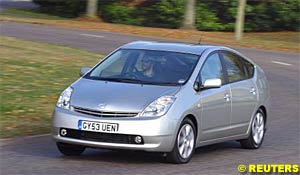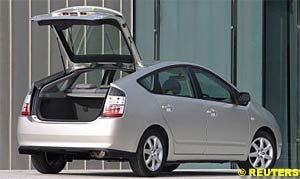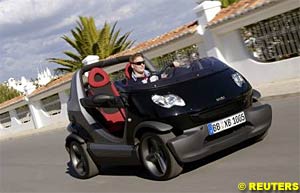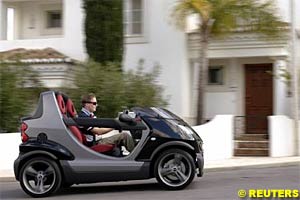

Automotive News and Reviews for the Petrolhead
Reuters Motoring Commentator
In this week's issue:
- Future Imperfect
- Smart, But Only in Name
If you can't stand the heat of global warming, get out of your internal combustion dinosaur.
That's the message Toyota is sending out with its brand new Prius, which it claims to be the world's cleanest family car. With only 104 grams of carbon dioxide emitted per kilometre travelled, it is lots cleaner than even the tiny 700cc Smart, yet is the size of a Ford Mondeo and has the torque output of a supercar.
Up until now, your choice of eco cars has been frankly pitiful. Purely electric cars are a disaster: they take forever to charge up, only have a range of 50 miles and the batteries are very expensive to replace. Hybrids that combine petrol and electric motors answer all these problems.
The Prius's petrol engine keeps the electric powerpack charged, gives it has a range of 650 miles and all the hybrid components are guaranteed for eight years. Here we have a tantalising glimpse into a world where performance, fun and eco responsibility can all live together happily.
Torquing Performance
Did I say performance? Believe it or not, yes: the Prius is a quick car. It will get to 60mph in just over 10.5 seconds, not bad for a car of this size. But far more impressive is what happens when you put your foot down at 30mph. The Prius simply rockets away. Look at the spec sheet and you'll see why: when the petrol and electric motors join together they pump out a scarcely believable 452lb ft of torque - that's more than a BMW X5 4.6 V8! And yet the Prius does 65mpg?
So what's the secret? The petrol engine is a surprisingly downmarket 1.5-litre petrol unit but an extra electric motor is fed by a battery pack that is recharged by the engine and even by the brakes. That means that when you ask a lot of your car, it delivers punch. When you're cruising, the electric motor turns off and the battery gets recharged.
Strange - But Fun
There are some other curious things to get used to. I love the funky touch screen LCD in the centre console that shows you what bits of the powertrain are doing what at any given time. And this is probably the easiest car I've ever driven. To turn it on, you simply press a hi-fi-style power-on button in the dash. No keys, no fuss. Flick the tiny automatic gear lever in the dash to ?drive' and you're off - there's only one forward gear and one reverse gear. Roadholding is pretty good although it's not what you'd describe as a fun drive.
The biggest single problem with the Prius is exposed when you want to climb up a hill. The CVT (continuously variable transmission) promptly instructs the engine to rev up to its red line and stay there, creating a most un-eco-friendly noise. And when you feather the throttle, the CVT gearbox hunts around to set the engine speed at the right level, never sounding very convincing that it has got it right.
So with what does the Prius compete? Its fastback roofline looks utterly unique and it is much more a ?proper' car than the old Prius was. Interior space is excellent although it is priced very much alongside the slightly larger Toyota Avensis, so it does suffer by comparison.
The battery pack may be small, slotting in under the floor behind the rear seats, but being there does raise the load floor considerably. Just 408 litres of boot space (1210 with seats folded) is meagre for a car selling in the Mondeo sector. Indeed it suffers against £20,000 rivals in a number of areas: the cabin feels too plasticky in too many areas, the car is basically is too narrow and too short, and some items of equipment that you'd expect are missing. If you're worried about reliability, however, don't be: Toyota is giving the hybrid powertrain an eight-year or 100,000 mile warranty.
The new Prius is certainly premium-priced, starting at £17,495, and compared as a straight swap for a Ford Mondeo, it does look overpriced. But the Prius qualifies for a government PowerShift rebate of £1000 and is exempt from the London congestion charge. Also it does 65mpg and, if you're a company car driver, it has the lowest CO2 rating of any car on sale, so you're in the lowest benefit-in-kind tax bracket. And unlike the disastrously depreciating old Prius, the new one should keep about a third of its value after three years.
So is this the car we will all be driving in ten years' time? Probably. The petrol-head in me says, enjoy the oil while it lasts and have more fun for my £17,500. But a green angel of conscience pipes up saying, the real price is not taking action to save the planet now. If nothing else, the Prius will say more about your eco-credentials than any bumper sticker ever can.
Written by Chris Rees
No roof. No windscreen. No windows. No doors. No doubt about it, we're can only be talking about one car. Welcome to the Smart Crossblade, either the most eloquent expression of automotive Zen or just the daftest car ever made.
My grandmother always told me to beware of extremes. "Everything in moderation," she would intone. She must have had the Crossblade in mind as the very antithesis of moderation, for it is in short supply indeed in this car. Just try driving anywhere in it. The reactions you get are extreme to say the least. Schoolgirls scream. Grown men double up in laughter as you go buy. People shout things at you - and I'd say about half were complimentary ("funky car, man" etc), the other half were definitely extracting the Michael.
Sitting on a Blade
So what's it like to drive a car with no roof and no windscreen? Throw away all notions of what you think driving is about. You sit on, rather than in, the Crossblade. As soon as you're above 30mph, your nostrils start flaring in the airstream and the black-out goggles you donned are wobbling like Eric Morecambe's specs.
If you forgot to wear a hat - or better still a crash helmet - you'll spend the next hour untangling the knots in your hair and wiping gravel from your brow. The first time I drove the Crossblade, I burst into uncontrollable laughter at the wheel, perhaps in sympathy with most of my fellow road users, who were doing the same thing.
The hilarity fades fast. Very quickly you come to terms with the fact that you're driving a roller skate, and not a very good roller skate at that. Despite the extra power that Smart has given the Crossblade - it's tuned up to 70bhp, so hold on to your hat, literally - it still sounds and behaves like a sewing machine motor. And Smart has done nothing about the frankly dreadful automatic gearbox that afflicts the ordinary Coupe. The time it takes for the 'box to change up a gear is so long that you've slowed down almost to the point where you need to change down a gear again. Lurch? I nearly cried.
Wheely Strong Grip
With the Crossblade, you find yourself in bizarre situations. I got stuck on a single track country road with a dumper truck coming the other way. I had to reverse up as close to the edge of the lane as possible, only to find that I'd been stung on the leg because nettles had poked their way into the cockpit. And while parked up, I got caught in a shower, forcing me to get acquainted with the nylon tent that Smart supplies to keep the car dry. I'm not joking - it even has one of those dome-tent poles and sort of pegs that attach to the car's underside.
So let's sum this up. Here is a car with no roof, no doors and no windscreen. It has no equipment either, doing without air vents, a CD player or even a rev counter. You can only buy it in a shade of black. It has a water-repellent plastic interior with drainage channels and even a little waterproof hood for the airbag to stop it short-circuiting.
For getting rid of so much equipment, Smart has virtually doubled the Smart Coupe's price to the level of an Audi A3. At least in theory. Check out eBay and most weeks you will find brand new examples being auctioned by a dealer reaching prices of £8-9,000. Officially sanctioned? Probably.
Written by David Summer Smith
![]() Future Imperfect
Future Imperfect
 How does it do it? The answer is, through an electric motor that works in tandem with a conventional 1.5-litre petrol engine. It's called hybrid technology and, having driven the new Prius, I am forced to declare that it is the future - even though it's not a future perfect.
How does it do it? The answer is, through an electric motor that works in tandem with a conventional 1.5-litre petrol engine. It's called hybrid technology and, having driven the new Prius, I am forced to declare that it is the future - even though it's not a future perfect.
 There is a button on the dash that puts the car in full ?electric' mode. The Prius is the world's only hybrid that can run on battery power alone, rather than using both electric and petrol engines at the same time. This is A Very Laudable Thing, and useful if you're setting off first thing in the morning and don't want to pollute your local neighbourhood. But it's all very limited by the fact that you can only travel 2km maximum on battery power alone. And it switches the petrol engine on automatically if you exceed 30mph.
There is a button on the dash that puts the car in full ?electric' mode. The Prius is the world's only hybrid that can run on battery power alone, rather than using both electric and petrol engines at the same time. This is A Very Laudable Thing, and useful if you're setting off first thing in the morning and don't want to pollute your local neighbourhood. But it's all very limited by the fact that you can only travel 2km maximum on battery power alone. And it switches the petrol engine on automatically if you exceed 30mph.
![]() Smart, But Only in Name
Smart, But Only in Name
 So this is not a car to be retiring in. Smart knows the Crossblade's appeal is, what is the phrase? "selective". It's only making 2000 of the things, all in left-hand drive. When you see the official price tag - £16,000 to you, sir - it suddenly dawns on you that you've entered a netherworld of fantasy. What is the typical owner profile? I'd say it's a St Tropez yacht owner with a boat big enough to store one on board, ready to roll out when you dock. Or it's someone with a screw loose and a loose wallet.
So this is not a car to be retiring in. Smart knows the Crossblade's appeal is, what is the phrase? "selective". It's only making 2000 of the things, all in left-hand drive. When you see the official price tag - £16,000 to you, sir - it suddenly dawns on you that you've entered a netherworld of fantasy. What is the typical owner profile? I'd say it's a St Tropez yacht owner with a boat big enough to store one on board, ready to roll out when you dock. Or it's someone with a screw loose and a loose wallet.
 One thing I do like is those enormously fat three-spoke wheels, which look very funky indeed. If there were a prize for the ratio of tyre width to car length, the Crossblade would get the Oscar and Nobel prize rolled into one. Roll is something you'll never get because there is so much grip from the rubber that, no matter how hard you press, it never comes unstuck. At least, not unless you're doing insane speeds which, believe me, you don't want to do.
One thing I do like is those enormously fat three-spoke wheels, which look very funky indeed. If there were a prize for the ratio of tyre width to car length, the Crossblade would get the Oscar and Nobel prize rolled into one. Roll is something you'll never get because there is so much grip from the rubber that, no matter how hard you press, it never comes unstuck. At least, not unless you're doing insane speeds which, believe me, you don't want to do.
© 2007 autosport.com . This service is provided under the Atlas F1 terms and conditions.
|
Volume 9, Issue 50
Articles
Auto-Union V16: The Magnificent Beast
The Most Successful F1 Cars Ever
2004 Countdown: Facts & Stats
Columns
The Fuel Stop
Bookworm Critique
On the Road
Elsewhere in Racing
The Weekly Grapevine
> Homepage |